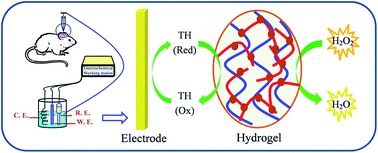A durable non-enzymatic electrochemical sensor for monitoring H2O2 in rat brain microdialysates based on one-step fabrication of hydrogels†
Abstract
A non-enzymatic electrochemical H2O2 sensor was developed by in situ fabrication of biocompatible chitosan (CS) hydrogels, in which a specific recognition molecule for H2O2, thionine (TH), was stably immobilized via one-step electrodeposition. Electron transfer of TH was facilitated in the CS/GPTMS/TH (GPTMS: γ-glycidoxypropyltrimethoxysiloxane) hydrogels with an electron transfer rate constant (ks) of 3.5 ± 0.1 s−1. Meanwhile, TH in CS hydrogels maintained high electrocatalytic activity toward H2O2. The developed sensor exhibited a fast amperometric response toward H2O2 within 7 s and a linear response for H2O2 ranging from 5.0 × 10−6 to 6.9 × 10−4 M with a detection limit of 1.0 × 10−6 M. In addition, the non-enzymatic electrochemical sensor exhibited long-term stability with a current decrease less than 5.0% in 18 days and good reproducibility with a small deviation of 7.2%. The remarkable analytical performance of the present sensor provided a promising model for durable monitoring of H2O2 in rat brain microdialysates, which is very useful for understanding the biological effects of H2O2 on the pathological and physiological processes.

- This article is part of the themed collection: In vivo analysis

 Please wait while we load your content...
Please wait while we load your content...